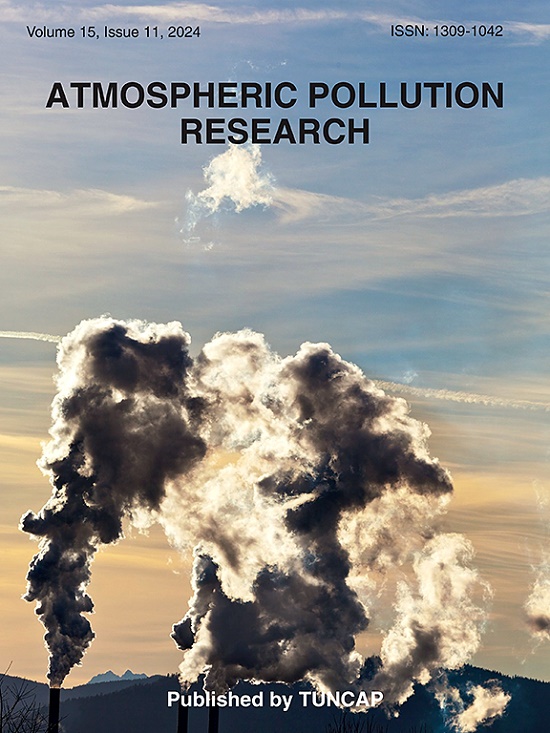考虑空间影响范围的土地利用特征对大气污染物浓度的影响
IF 3.9
3区 环境科学与生态学
Q2 ENVIRONMENTAL SCIENCES
引用次数: 0
摘要
从统计概率到机器学习技术的预测模型已被用于改善和管理城市空气质量。然而,收集空气质量信息的空气质量监测站(AQMS)数量有限。本研究建立了一个模型,解释了韩国约443个AQMS测量的六种空气污染物(so2、CO、O3、NO2、PM10和pm2.5)与植被指数、地形和土地覆盖要素等因素之间的关系。该模型分析了土地覆盖变化对空气污染物浓度的影响,并推导了土地利用变化导致空气质量变化的预测情景。尽管大约360个AQMS的样本量相对较小,但与代表性的机器学习技术Xtreme Gradient Boosting相比,多元回归分析显示出更高的解释力。空气污染物浓度的最佳空间范围因空气污染物而异。在12000 m处,多元回归分析中SO2的R2最高,为0.34;11000米CO值0.27;6000m时O3为0.50;在18000米处NO2为0.70;在18000 m处PM10为0.49;11000米的PM2.5值为0.48。研究发现,某些土地覆盖特征对空气质量有显著影响,而小规模恢复对空气质量改善的影响微乎其微,而大规模开发大大增加了污染物浓度。该研究为改善城市空气质量的城市规划和政策制定提供了重要信息。本文章由计算机程序翻译,如有差异,请以英文原文为准。
Impact of land use characteristics on air pollutant concentrations considering the spatial range of influence
Prediction models ranging from statistical probability to machine learning techniques have been employed to improve and manage urban air quality. However, the number of air quality monitoring stations (AQMS) for the collection of air quality information is limited. This study established a model that explains the relationship between six air pollutants–SO2, CO, O3, NO2, PM10, and PM2.5–measured by approximately 443 AQMS in South Korea and factors, such as the vegetation index, topography, and land cover elements. The model analyzed the impact of land cover changes on air pollutant concentrations and derived scenarios predicting changes in the air quality due to land use changes. Despite the relatively small sample size of approximately 360 AQMS, multiple regression analysis demonstrated higher explanatory power compared with Xtreme Gradient Boosting, a representative machine learning technique. The optimal spatial range for explaining air pollutant concentrations varied for each air pollutant. The highest R2 in the multiple regression analysis was 0.34 at a distance of 12,000 m for SO2; 0.27 at 11,000 m for CO; 0.50 at 6000 m for O3; 0.70 at 18,000 m for NO2; 0.49 at 18,000 m for PM10; and 0.48 at 11,000 m for PM2.5. Certain land cover characteristics were found to significantly affect air quality, whereas small-scale restoration had a minimal impact on air quality improvement, and large-scale development substantially increased pollutant concentrations. This study provides essential information for urban planning and policymaking aimed at improving urban air quality.
求助全文
通过发布文献求助,成功后即可免费获取论文全文。
去求助
来源期刊

Atmospheric Pollution Research
ENVIRONMENTAL SCIENCES-
CiteScore
8.30
自引率
6.70%
发文量
256
审稿时长
36 days
期刊介绍:
Atmospheric Pollution Research (APR) is an international journal designed for the publication of articles on air pollution. Papers should present novel experimental results, theory and modeling of air pollution on local, regional, or global scales. Areas covered are research on inorganic, organic, and persistent organic air pollutants, air quality monitoring, air quality management, atmospheric dispersion and transport, air-surface (soil, water, and vegetation) exchange of pollutants, dry and wet deposition, indoor air quality, exposure assessment, health effects, satellite measurements, natural emissions, atmospheric chemistry, greenhouse gases, and effects on climate change.
 求助内容:
求助内容: 应助结果提醒方式:
应助结果提醒方式:


